Introduction
SAP has been the leader in ERP (Enterprise Resource Planning) and EAM (Enterprise Asset Management) for mid-market and enterprises across businesses of all kinds.
Data management, specifically, master data cleansing and governance features in SAP, while quite elaborate and extensive, don’t solve for several industry-use cases – which explains the growing popularity of add-on software solutions within SAP.
The requirements by enterprises across several industries like manufacturing, retail, wholesale and services are diverse, complex and unique depending on the industry, type of operations and size of the enterprise.
In this article, we will list some of the leading SAP master data management software tools for a range of diverse requirements, their unique selling propositions, drawbacks and some recommendations for choosing the right solution.
Verdantis
Verdantis solves for Master Data management challenges through it’s 2 flagship products, Harmonize & Integrity that solve for Data Cleansing & Data Governance respectively.
Both Integrity & Harmonize are purpose-built for managing data domains specific to manufacturing & production-heavy operations, which primarily include;
1. MRO Spare Parts Data
2. Equipment or Fixed Assets Data
3. Services Master
While other data domains like Supplier Master and Customer Master are also supported within both the platforms, far superior solutions exist in the market for companies who are looking to solve for these two data domains.
Verdantis is an ideal solution for Master Data Management if you’re representing an asset-intensive organization with large scale production or manufacturing operations.
The software is AI-Native and deploys several industry-trained AI models for data enrichment, deduplication, standardization and synchronization across systems, within the two flagship products mentioned earlier
If you representing a company from any of the below industries, it may be worthwhile to explore Verdanits’ SAP master data management suite.
Verdantis’ clientele includes fortune 500 Companies, mid-market and enterprise customer across the industries listed below
And here are 2 videos explaining how Verdantis’ Data Governance & Data Cleansing products work, while integrating directly with SAP ERP systems like ECC, S4/Hana or as a bolt-on solution into SAP MDG
Integrity - The Data Governance Product
Harmonize - The Data Cleansing Product
Both these products have built-in Agentic AI capabilities that solve for data extraction from unstructured documents, Data enrichment from verified supplier catalogues and data translations into several languages.
Verdantis supports implementation with S4/Hana, ECC and all SAP and Oracle source systems. The software also bolts-on directly with SAP MDG.
When to consider Verdantis’ MDM software suite ?
Cases when Verdantis' MDM Solutions are good fit
- For companies in manufacturing, production and asset-intensive operations
- For companies looking to address data-quality issues across their MRO materials, fixed assets and services master
- Curious to see how AI agents solve for data quality issues
Cases when Verdantis' MDM Solutions aren't a good fit
- For companies in a service-based, retail or wholesale operations
- For companies looking to address data-quality issues across their customer, products and employee master
- For companies interested in a holistic multi-domain master data solution
Should you find your data management challenges in sync with the above, you can schedule some time using the form below
SAP MDG
SAP MDG was one of the first data governance tools with a software-first approach and was launched way back in 2011.
The tool has pioneered the concept of data governance, and introduced the idea that preventing data quality from being eroded is far more prudent than repetitive data cleansing.
The software supports all data models including MRO, Materials, business partners and equipment – Some of these models may require additional licensing and pricing can vary.
Several data normalization, and cleansing tasks can also seamlessly be managed within MDG and it acts as a swiss-army knife for all things related to data management in SAP.
Features: Data Consolidation, Data Cleansing, Centralized Data Governance across ERPs, Rule-based Frameworks for normalizing legacy data, data de-duplication features across L1 and L2 duplicates.
For SAP users, the out-of-the box integration with MDG is a breeze and makes data management a bit easier. However, non-SAP users struggle with integrating MDG into their source systems citing implementation complexity.
This post covers SAP MDG in great detail, including the best features and the limitations that enterprises often face while implementing data governance in their SAP systems.
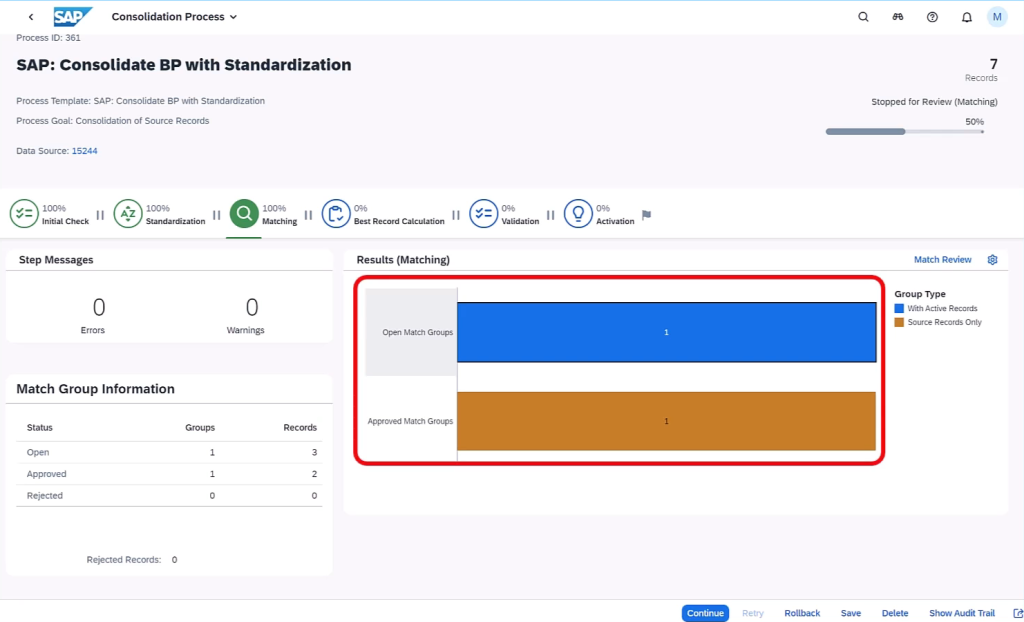
RELTIO Master Data
Reltio is a cloud-native, multi-tenant SaaS platform with advanced master data management functionalities,
Reltio is primarily used for governing customer, supplier and product master data and is widely used by enterprises that need real-time, clean and connected data for seamless operations across business functions.
Features:
1. Real-Time Data Unification: Merges data from multiple SAP and external sources to create a single “golden data record” for complete and reliable information, processed real-time
2. AI Powered Data Matching: AI-models that are programmed to learn from user inputs ensure that data points are not duplicated, and can be mapped with data records across
3. Business Friendly UI: One of the most touted features about Reltio is the business-friendly UI that makes data entry and data management seamless even for non-technical employees.
4. Advanced Analytics: Reltio is positioned as a specialist Multi-Domain MDM software, once configured, users with the right accesses can connect datasets across different master data types for accurate org-wide analyticas.
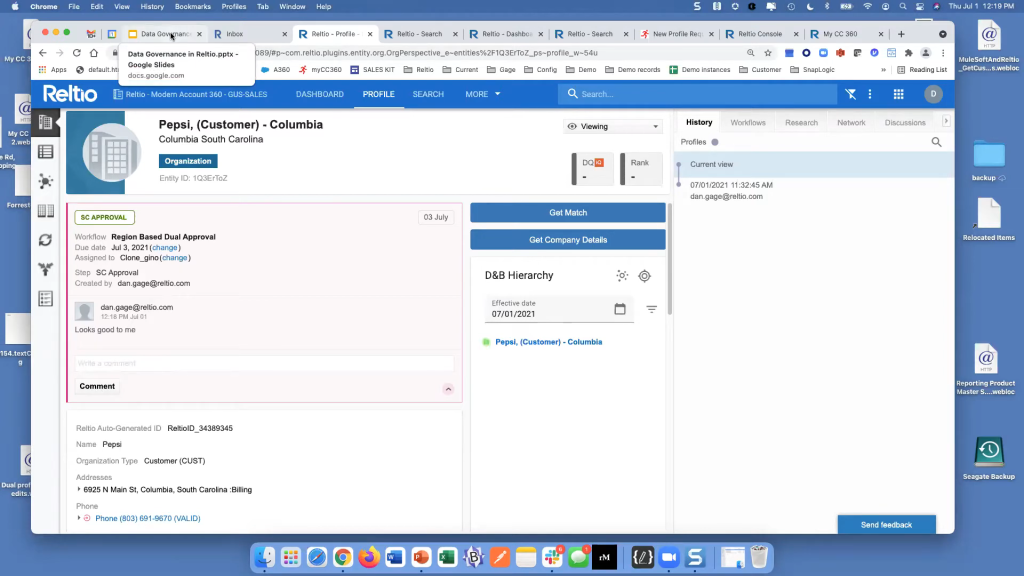
RELTIO Integration Options with SAP
Reltio team has developed several integration options so orgs can seamlessly connect the software with SAP source systems. Some of the integration options are as detailed below;
1. Pre-built SAP Connectors
2. Custom APIs for SAP S4/Hana, ECC and even for SAP MDG
3. Middleware Platforms like Mulesoft, Boomi or SAP PI/PO
COLLIBRA for SAP Data MDM
Collibra is not a master data management tool in the traditional sense, it doesn’t clean, merge, normalize of enrich data records in the traditional sense of an MDM tool. That being said, it is a cloud-native data intelligence platform that is frequently integrated into MDM systems to bolster governance and stewardship.
At the heart of Collibra’s approach is its Data Intelligence Platform, which brings together governance, cataloging, lineage, policy enforcement, and stewardship in a centralized and collaborative environment.
This allows enterprises to gain control over their master data—such as customer, product, supplier, finance, or employee data—by clearly defining data ownership, policies, rules, and quality standards.
In parallel, Collibra’s data stewardship and governance workflows enable organizations to assign roles and responsibilities for each data domain.
For example, a data steward may be responsible for ensuring that product data adheres to established standards, while a domain owner might approve any structural changes to vendor hierarchies.
These roles are embedded into Collibra’s workflow engine, which automates tasks such as approval of data changes, escalation of issues, and review cycles for policy updates.

To Note: Collibra doesn’t replace traditional MDM systems—it enhances them. By embedding governance into the fabric of master data management, Collibra ensures that master data is not only clean and centralized but also governed, contextualized, and trusted.
Its strength lies in creating a unified governance framework where business and IT collaborate seamlessly, enabling data-driven decision-making with confidence.
STIBO Systems [STEP]
STIBO Systems Platform, also called STEP, is a fully flexible SaaS platform that processes and governs data across domains; they offer multi-domain MDM solution that is uniquely strong in both product master data management and data governance by design.
Unlike Collibra, which acts as a governance wrapper around other data systems, STEP is an MDM engine in its own right, managing and mastering core data entities while embedding governance controls directly into the data lifecycle.
One of STEP’s most powerful capabilities lies in its collaborative workflow engine, which is designed for real-world complexity. Governance isn’t limited to IT or centralized data teams. Instead, it empowers business users and subject matter experts to take ownership of the data they work with daily. Through intuitive interfaces and dashboards, users can see what tasks are pending, what data needs remediation, and what records are ready for syndication or export.
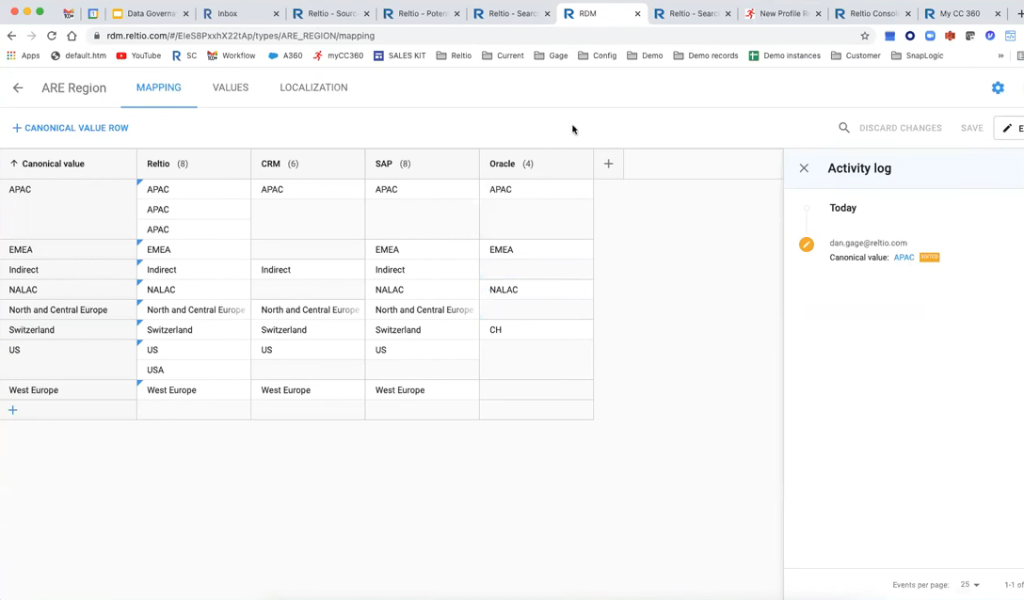
STIBO Integration Options with SAP
Furthermore, Stibo’s platform is API-driven and cloud-native, making it a solid fit for modern enterprises looking to integrate their MDM and governance workflows into broader digital transformation or e-commerce strategies.
Whether syncing data with SAP S/4HANA, embedding workflows into Microsoft Dynamics, or exposing product master data to headless commerce engines, STEP acts as a governance-first data backbone.
Boomi Master Data Hub
Boomi’s Master Data Hub is a cloud-native, multi-tenant solution that focuses on the synchronization, stewardship, and governance of master data across distributed systems. True to Boomi’s roots, the Master Data Hub is tightly integrated with its iPaaS backbone, which means it excels at moving, transforming, and coordinating data across applications and environments — both cloud and on-premises.
Where Boomi stands out is in scenarios where companies are grappling with data sprawl across a multitude of SaaS applications, CRMs, ERPs, and data lakes. For example, a mid-sized enterprise using Salesforce, NetSuite, and a legacy HR system may find themselves constantly struggling with conflicting customer or employee records. Boomi’s Master Data Hub is designed to sit in the middle of this ecosystem and act as a lightweight, central authority for trusted master data, while also offering governance capabilities to maintain quality and consistency.
What really sets Boomi apart is how it handles distribution and synchronization of mastered data. Thanks to its iPaaS foundation, the Boomi platform can push clean, governed records back to source systems (like SAP, Workday, Salesforce, or a data lake), keeping all applications in sync with the master record.
This is particularly useful in fast-paced business environments where real-time data consistency is critical, and data governance can’t be a bottleneck.
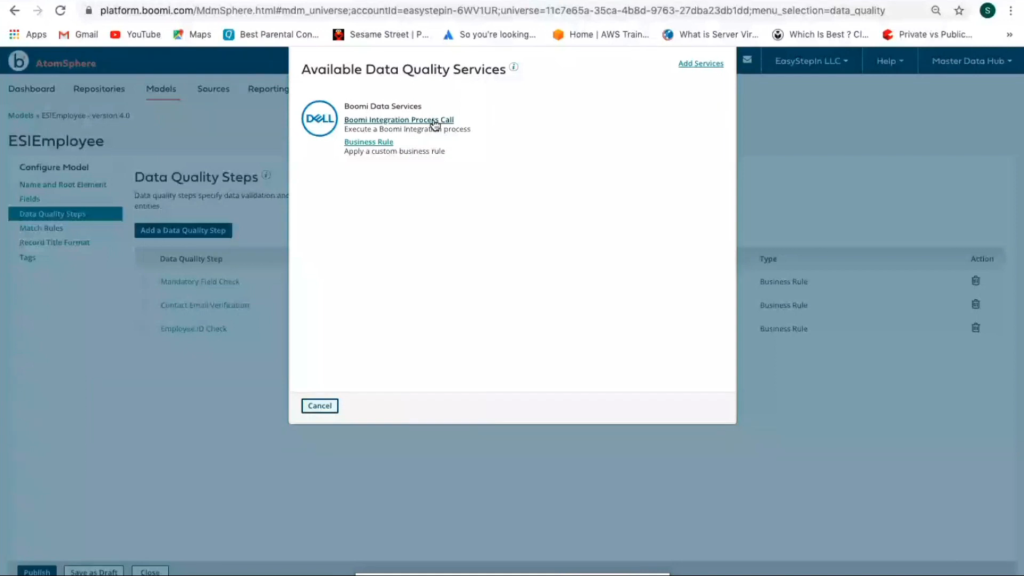
BOOMI Integration Options with SAP
Boomi integrates seamlessly with SAP systems, including SAP ECC, S/4HANA, and SAP MDG, offering a lightweight, cloud-native approach to master data synchronization and governance.
Through certified connectors, Boomi supports IDocs, BAPIs, OData, and REST APIs to enable bidirectional data exchange with SAP, making it ideal for real-time or batch-based integration. While SAP MDG governs master data within the SAP ecosystem, Boomi acts as a complementary layer—distributing golden records to non-SAP systems or feeding external data into MDG workflows for validation and enrichment.
It’s especially effective in hybrid environments, where some domains are managed in SAP and others in CRM, PIM, or legacy systems. Boomi also enhances governance by enforcing data quality rules, triggering stewardship workflows, and maintaining audit trails before and after data reaches SAP.
Its low-code interface allows rapid orchestration of master data flows across systems without heavy IT intervention. As a result, organizations undergoing ERP transformations or M&A integrations can achieve faster time to value while maintaining trusted, synchronized data across the enterprise.
Syniti
Syniti was formerly known as BackOffice Associates, and is a global leader in enterprise data management solutions, with deep specialization in data integration, data quality management, standardization and governance with SAP environments.
While it’s core specialization is managing data migration projects in SAP, specifically, managing migrations to newer ERP systems like S4/Hana or another ERP system altogether. The company has also partnered with SAP and enables its customers to move to newer versions of ERP + EAM systems with cleaned, governed data.
As per the available information online, it seems that Syniti does not separately offer individual products for different data management operations, instead, the company’s flagship product solves for data integration, data governance, consolidation and data migration in one single place.
The core data platform, enables end-to-end master data management and governance through features such as data discovery and profiling to automatically identify quality issues, data matching and deduplication using intelligent algorithms to unify entities across systems, a business rules engine that lets organizations define and enforce rules tailored to specific domains like customer, supplier, material, or finance, robust workflow and stewardship tools for task assignment and issue resolution, and role-based governance to ensure users can only access or act on data they’re authorized to handle, supporting compliance and security.
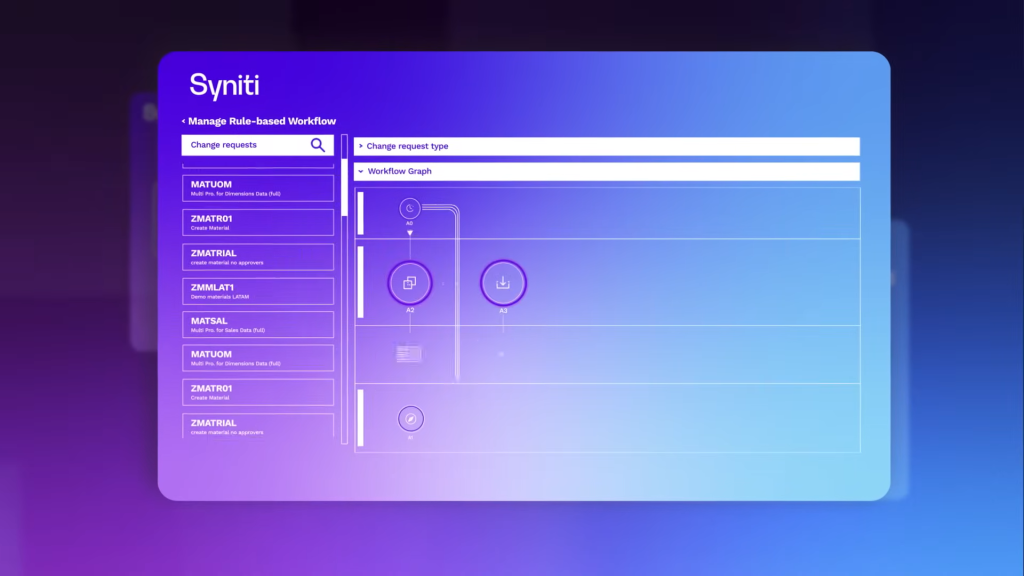
Syniti Integration Options with SAP
Syniti integrates seamlessly with SAP through native connectors and certified solutions, enabling smooth data exchange between SAP ECC, SAP S/4HANA, and the Syniti platform; it supports SAP Advanced Data Migration by Syniti, co-developed with SAP, which facilitates secure and efficient migration of master and transactional data.
The platform also leverages SAP Business Technology Platform (BTP) and SAP Data Services for deeper alignment, while offering real-time validation, data enrichment, and governance workflows within SAP environments—ensuring that all master data changes comply with business rules before reaching the SAP system.
In Conclusion
Being one of the largest ERP systems in the world, the collection of platforms and tools for data governance in SAP is quite varied, choosing the best SAP data governance software will depend on industry specialization, type of master data model, requirements as far as MDM is concerned (de-duplication, enrichment, structuring) and so on.
Each of these software solutions specialize in data governance and MDM for a very niche set of requirements, and there’s no single blanket answer that a professional can advice without understanding client requirements first.
At Verdantis, we’ve long been an specialist partner in master data management for manufacturing and production-heavy corporations globally and we’ve led the way in effective manufacturing and maintenance operations for leading billion $ enterprises





